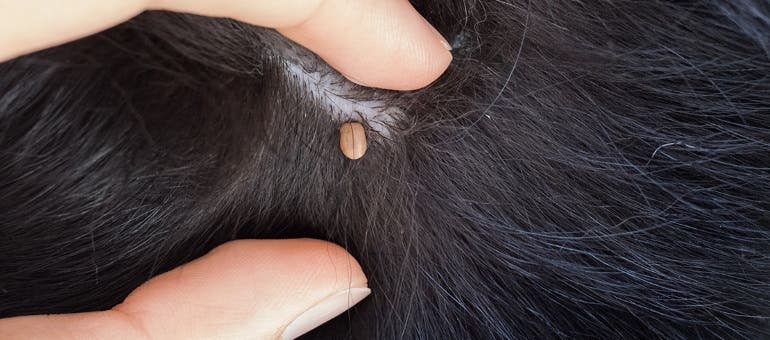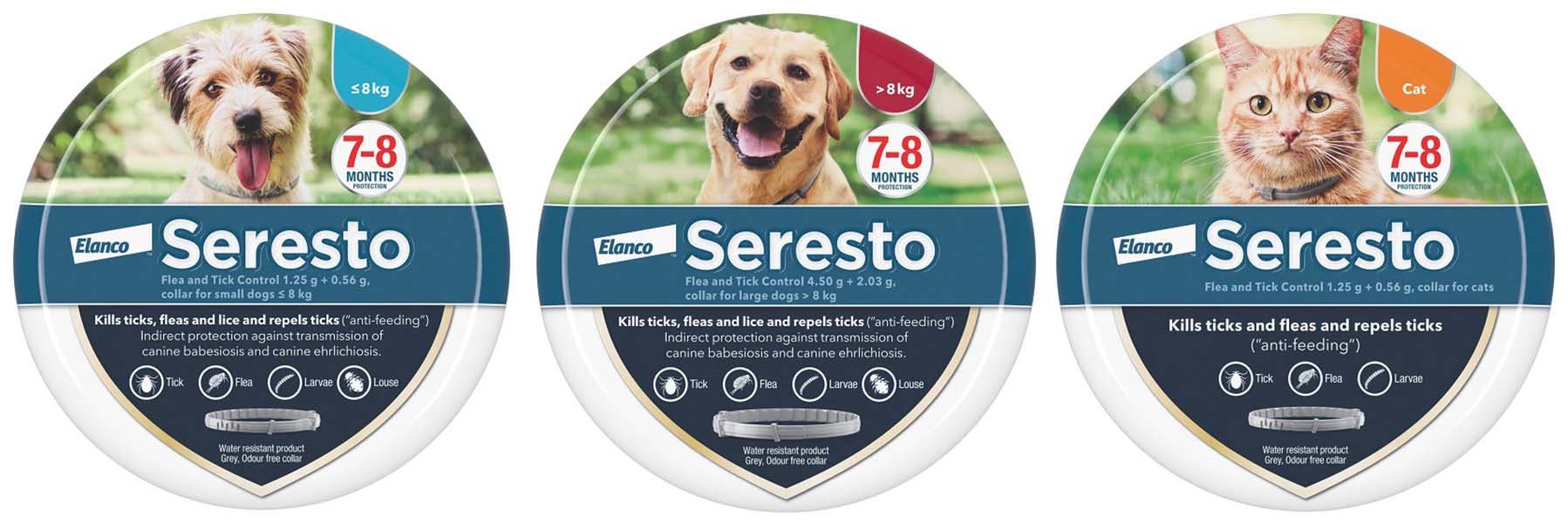Just like our human skin, a dog’s skin will change from day to day and over time it will age. You may notice differences such as a change in texture, or even lumps or bumps. These may be a harmless skin tag or scab, but sometimes they can also indicate a tick bite, which can spread diseases to your pet.
In this short guide, we show you how to tell if your dog has a tick, a scab or a skin tag so you can help to keep your pet healthy.
How to tell the difference between a scab and a tick
Ticks are blood-thirsty critters that can easily latch onto your pet’s skin, if they are unprotected while enjoying the outdoors. The tick simply positions itself on top of a blade of grass and use their front legs to detect a passing host.
Ticks change in appearance as they feed – they initially appear as small dark brown spots but when they feed the tick fills with blood and becomes engorged, and they could easily be mistaken for a scab.
If you’re unsure whether your dog has a tick or a scab, part your dog’s fur and look closely – scabs are usually flat against the skin, but ticks stick out, especially as they grow in size.
Where do scabs on my dog come from?
Dogs love to explore their environment, running through the woods, chasing a ball or going on a long walk. It’s only natural they will pick up a few cuts and scrapes along the way.
But some scabs can indicate more treatment is needed:
- Allergies – If your dog is allergic to something, this irritation can cause your dog to scratch the itch, inflaming and damaging the skin which can lead to scabbing.
- External parasites – Tick bites can sometimes irritate dogs and your pooch might attempt to scratch these nasties off, which can break the skin. Fleas also pose a problem. Some dogs are allergic to flea saliva, a condition called Flea Allergy Dermatitis (FAD), triggered by flea bites. It causes intense itchiness and dogs will scratch and bite their skin excessively to relieve the itch, which can cause scabs.
How to tell the difference between a skin tag and a tick
Could that bump on your dog’s body be a skin tag or is it a tick? While skin tags are perfectly normal, it’s important to identify a tick early on, so you can remove it as soon as possible. The longer your pet has a tick attached, it increases the risk of your pet contracting a disease.
Here’s how you tell the difference between a tick and a skin tag:
- Colour – Skin tags tend to be the same colour as your pet’s skin, while ticks are often dark brown or grey in colour. Spotting a tick over a skin tag is quite straight-forward if your pet has light-coloured skin and fur. You may need to take a closer look using a magnifying glass if your dog has dark-coloured skin and fur.
- Legs – Ticks are part of the arachnid family, so just like spiders, adult ticks have eight legs which you should be able to see on closer inspection.
- Movement – Even an attached tick will move their legs when provoked. Try touching the tick with a gloved finger and watch to see any legs moving. If the tick isn’t yet attached, it may run away from you, so be careful to examine your pet outside your home just in case you lose sight of the little critter.
- Growth – If it gets bigger over a period of a few days, it may be more likely to be a tick rather than a skin tag.
Still can’t tell? If you’re not sure if the small bump is a tick or a skin tag, ask your vet to check it to be on the safe side.

Should I worry about a skin tag on my dog?
It’s a good idea to visit your vet to examine any skin lumps on your dog that you are concerned about to rule out anything serious. If your vet confirms it is a skin tag, in most cases they are a minor problem and there is nothing to be worried about.
Remember, never try to remove a dog’s skin tag yourself.
My dog has a tick, how do I remove it?
If you find a tick, you’ll want to remove it right away. Ticks aren’t just a nuisance for your dog, they can also pass on serious tick-borne diseases, such as Lyme disease, to both your dog and to you!
A tick removal tool, such as a tick hook, easily and quickly pulls out a tick from your pet’s skin. These tools can prise out the whole tick, including their mouthparts, in one go, unlike tweezers, which can leave bits of the tick in your dog’s body.
Read our guide for step-by-step instructions on removing ticks from dogs.
Effective tick protection for dogs
Dogs are bound to pick up ticks from the environment, especially if they’ve been running around wooded areas or through long grass – a tick’s favourite place to hide in wait for their next blood meal.
Now you know what to look for, it’s wise to regularly check your dog for ticks, feeling for small bumps over the skin that could indicate a tick bite. Dog owners should also be sure to check themselves in case they have become a tasty tick meal!
The most effective way to protect your dog from ticks biting in the first place is to use a tick preventative product, such as Seresto Flea and Tick Control collar. Seresto’s active ingredients work on your dog’s skin and fur, actively repelling and killing ticks (and killing fleas) through contact, no tick bites required!* Seresto also offers 7 to 8 months of protection from fleas and ticks in a single application – the longest lasting protection available.
*Information is regarding mode of action and is not intended to imply parasites can be completely stopped from biting.

